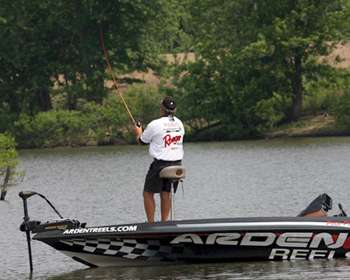
Have you ever had one of those days when conditions were perfect for throwing a buzzbait, but for whatever reason the fish would barely show any interest?
Elite Series pro Pete Ponds has the solution. "If the bass will come up and nip at a buzzbait, they'll eat a little subsurface crankbait like a Bandit Footloose," he says. "They're most effective in situations where you have a lot of grass that's just below the surface, or a lot of pad stems." Since super-shallow crankbaits like the Footloose dive no more than an inch or two below the water's surface, Ponds explains that they're the perfect application for an early spring search bait as well.
"When bass first start moving into the shallows, they're great," he says. "Water temperatures will usually be in the low 60s, maybe up to 63 degrees, so topwater baits aren't quite as effective. The whole key to this deal is a 'stop and start' retrieve." Ponds, who rigs his subsurface bait on 17-pound fluorocarbon, insists on a stop-and-go retrieve for attracting the most attention.
"The heavier line helps the bait get down a little bit, but it still runs right under the surface," he says. "The retrieve is very, very important. You won't get nearly as many bites if you're just reeling it straight back to the boat as you will by either retrieving with a pumping motion or stop-and-go retrieve." The super-shallow crankbait, not unlike its topwater cousin, is usually going to be more effective on overcast days, Ponds says. "It's just not as good when the sun is out. I'll probably pick another bait, like a spinnerbait, if the sun's shining.
"That's not to say that bass won't hit it when the sun is shining, but I'm looking for the most effective bait to use in order to cover a lot of water as quickly as possible." Ponds relies on the water clarity to determine his color selection for the most part, but he also points out that bream are usually bedding around this same timeframe which can impact his color choice.
"Usually in clear water I want a more natural color, and in stained water I want to use more of a perch color," he says. "Because of the bream bedding, a parrot-colored bait can also be really effective." In overcast conditions, Ponds relies on the shallow crankbait to cover large areas of water very quickly. "You can cover a vast area of water really quick and pinpoint groups of fish by making long casts and quick retrieves," he explains.
"Other shallow-water techniques won't always allow you to do that." Once he's pinpointed a group of fish, Ponds points out that stealth becomes extremely important. "Because the water is so shallow, you stand a real good chance of spooking them off," he says. "I'll turn off my electronics and drop my Power-Poles and begin making casts in a pie-shaped arc. "It's kind of like squirrel hunting, in that you might have to sit there and wait for 10 or 15 minutes before they start coming in."
(Provided by Z3 Media)




